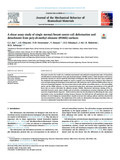| dc.description.abstract | This paper presents the results of a combined experimental and analytical/computational study of viscoelastic cell deformation and detachment from poly-di-methyl-siloxane (PDMS) surfaces. Fluid mechanics and fracture mechanics concepts are used to model the detachment of biological cells observed under shear assay conditions.
The analytical and computational models are used to compute crack driving forces, which are then related to crack extension during the detachment of normal breast cells and breast cancer cells from PDMS surfaces that are relevant to biomedical implants. The interactions between cells and the extracellular matrix, or the extracellular matrix and the PDMS substrate, are then characterized using force microscopy measurements of the pull-off
forces that are used to determine the adhesion energies.
Finally, fluorescence microscopy staining of the cytosketelal structures (actin, micro-tubulin and cyto-keratin), transmembrane proteins (vimentin) and the ECM structures (Arginin Glycine Aspartate – RGD) is used to show that the detachment of cells during the shear assay experiments occurs via interfacial cracking between (between the ECM and the cell membranes) with a high incidence of crack bridging by transmembrane vinculin structures that undergo pull-out until they detach from the actin cytoskeletal structure. The implications of the results are discussed for the design of interfaces that are relevant to implantable biomedical devices and normal/cancer tissue. | en_US |

